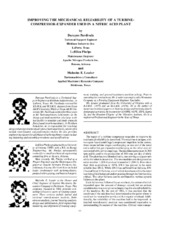| dc.description.abstract | The repair of a turbine-compressor-expander to improve its mechanical reliability is described. The machine is unique, with two open-faced centrifugal compressor impellers in the center, three steam turbine stages overhanging on one end of the rotor and a radial hot gas expander overhanging on the other end, all connected with curvic couplings. The machine operates at 18,500 rpm and is used in the production of 300 tons per day of nitric acid. The plant has two identical units, one serving as a spare unit while the other is in service. The two modules are designated as serial number 1 (SN-1) and serial number 2 (SN-2). Ever since their first acquisition in 1978, SN-1 has proven to be more reliable than SN-2. While SN-1 has suffered four failures, SN2 has suffered 13 failures, six of which have been while the rotor was being field balanced and/or passing through its first bending critical. The other failures can be attributed to various system failures at the plant. Each failure was followed by an overhaul, the extent of which depended upon the amount of damage caused, but no serious consideration was ever given to improving the overall reliability of the machine. By the end of 1992, it was decided that the condition of the machine had deteriorated to the point where it could not be returned to service with a regular overhaul. Additionally, the reliability of the machine had to be improved. A detailed rotordynamic analysis was considered imperative to understanding the nature of the machine. Critical rotor components were manufactured to replace existing ones. A detailed balancing procedure was adopted, and a mock-assembly was performed to set assembly clearances accurately prior to the final assembly. A shop balancing and assembly manual was written to closely control the entire overhaul. The rotordynamic study and procedures adopted to improve the reliability of the machine are described. Also included are the actual startup data. The repair procedures have proven extremely successful, as can be seen from a comparison of the startup data before and after the overhaul. Vibration amplitudes at startup, as the machine passes through its first bending critical speed, are lower than seen previously. The machine was installed in November 1993, and has been shut down and started numerous times. Each time the machine has come up to operating speed without any problems, indicating that the overall mechanical reliability of the machine has been significantly improved. The presented procedures can be easily adapted to improve the mechanical reliability of other machines with similar problems. | en |


